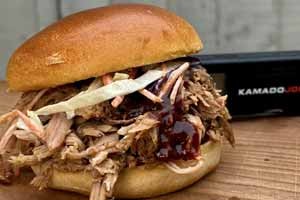Easy, tender BBQ pulled pork, loaded into buns with coleslaw and BBQ sauce.
How to Make Pork Belly Crispy
Achieving the perfect crispy pork belly is an art that any cook can master. Follow these steps to ensure a delicious crackling pork belly, whether you're roasting it in the oven or cooking it on the BBQ.
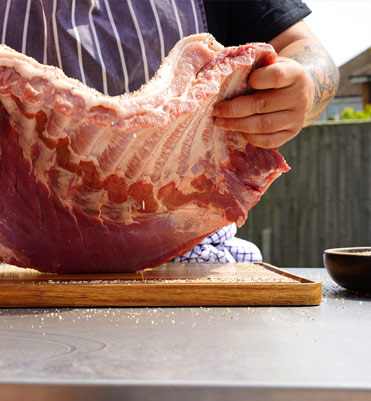
Buying, Trimming and Scoring
Use high-quality pork belly. Better quality meat has better fat distribution, which contributes to better crackling.
Ask your butcher to score the skin or use a very sharp knife to make fine cuts. This allows the fat to render and the skin to crisp up. Be very careful not to cut through the fat and into the meat.
Remove the skirt and other extra bits. These can be used to make a rich stock for soups and stews, adding depth to dishes like chilli.
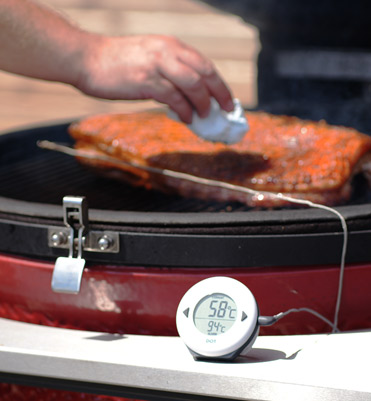
Drying and Salting
Ensuring thoroughly dry and well-salted meat is the most important step to getting crispy pork belly.
Pat the skin dry with paper towels. Dry between the cracks in the skin thoroughly. Any moisture will steam and prevent the skin from becoming crispy.
After drying, generously salt the skin. Use more salt than you think necessary. The salt helps draw out moisture, which is crucial for achieving that perfect crackle.
Drying and salting 24 hours ahead will create the best result; osmosis draws out the moisture, resulting in a crispier finish. To do this, follow the steps above and then place the pork on a wire rack over a tray and leave in the fridge.
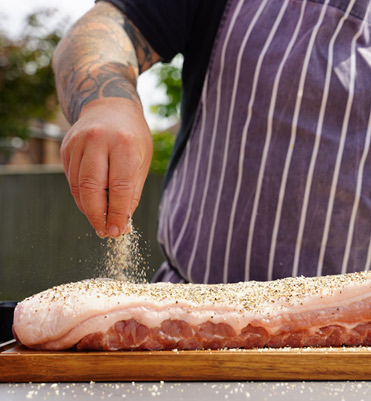
Oiling and Seasoning
Keep the skin side of the pork to salt only, but you can add oil and flavour to the meat side.
For a Sunday roast, enhance your pork belly with a rub of rosemary, thyme, and garlic for a classic herb flavour. Citrus zest from lemon or orange pairs beautifully with fennel seeds and apple slices for a fresh, aromatic touch. For a sweet and tangy glaze, brush with honey and wholegrain mustard, or add complexity with five-spice powder and a hint of brown sugar.
Temperature Monitoring
Monitoring the internal temperature of your pork belly as it cooks will help you make sure it’s on track the whole time.
The DOT is a great tool for this, as it will continually show you the current temperature and sound an alarm once it’s cooked. Barbecuers might like to opt for the Smoke thermometer so they can monitor their pit temperature as well, and use the remote receiver to track their progress without having to keep going back to the grill.
Make sure to insert your probe correctly for accurate results. To do this, insert the probe horizontally into the centre of the belly. Try to locate the thickest part of the meat, avoiding the fat layer. Ensure it’s securely in place and won’t move during cooking.
As always, once your DOT or Smoke lets you know your meat is done, check the joint all over using an instant-read thermometer like a Thermapen. The Thermapen ONE is the best thermometer for the job, with 1-second readings meaning you can check several places in a few seconds. It’s also handy for feeling the resistance of the meat, so you can be sure it’s tender enough.
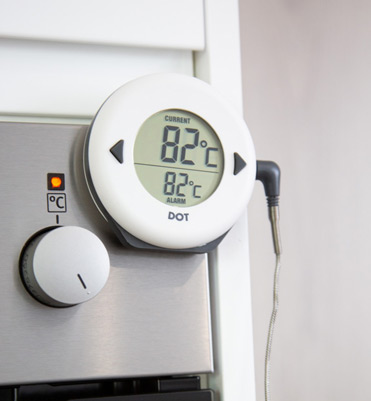
Tips for the Oven
Preheat your oven to 150 °C and place the pork skin side up. Try to ensure the surface is flat and well exposed to help it crisp up evenly.
Once your pork reaches around 90 °C internal temperature, turn the heat up to 220-240 °C and cook for 20-30 minutes more, until it reaches 95 °C. This high heat will help the skin puff up and become super crispy.
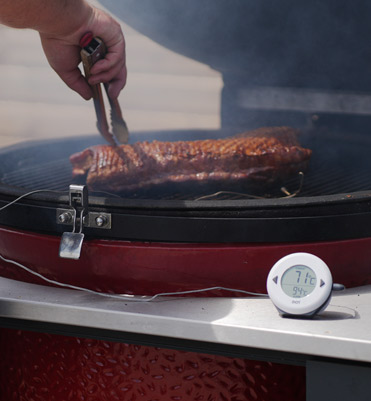
Tips for the BBQ
For smoking, cherry wood imparts a mild, sweet flavour without overpowering the meat. Avoid using too many strong flavours that can mask the natural taste of the pork.
Cook with the skin side down at 150 °C, using deflectors to ensure indirect heat. This will create a beautifully crispy skin without any burning.
Over-salt the skin slightly, then pat it during cooking to remove excess water that emerges, helping to keep the skin dry and aiding in the crisping process.
Use a BBQ thermometer to monitor your pit temperature to ensure it stays on track and make adjustments to your vents if the temperature rises or falls. Better yet, use a BBQ control fan like Billows to keep a steady pit temperature for you. Consistency is key to tender meat and crispy skin.
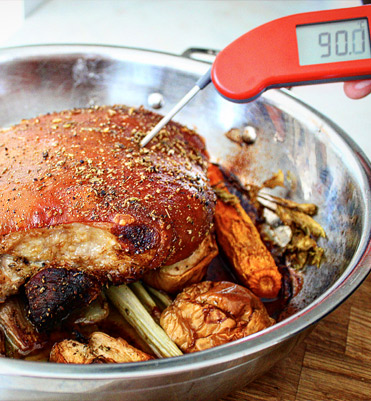
Finishing Touches
When your pork is perfectly cooked, the meat should reach an internal temperature of around
95 °C. At this point, the fat should have rendered to produce melt-in-the-mouth tender results. Use a Thermapen to check the temperature, as well as assessing the tenderness.
Once done, let the pork belly rest for at least 30 minutes before slicing. This allows the juices to redistribute, keeping the meat moist while the skin remains crisp. Plus, it's far too hot to carve and eat at 95 °C; you want it to drop at least 20 °C in temperature first.
Practise Makes Perfect
Cooking the perfect crispy pork belly is an art, and you might not master it on the first go. But don’t give up — you can only learn by trying, and your efforts will be well worth it once you get it spot on. If you find it hasn't crisped up enough, you might need to make it drier or saltier next time. Crunchy, golden brown roast pork belly will be yours eventually.
Related posts
 How to Cook Christmas Turkey on a BBQ
How to Cook Christmas Turkey on a BBQ
 5 Best Cooking Christmas Gifts 2025
5 Best Cooking Christmas Gifts 2025
 Mike Tomkins' Ultimate Beef Wellington
Mike Tomkins' Ultimate Beef Wellington
 Mike Tomkins’ Simple Salmon En Croute with Spinach
Mike Tomkins’ Simple Salmon En Croute with Spinach
 Christmas Marmalade Glazed Gammon
Christmas Marmalade Glazed Gammon
Search
Categories
- Baking (35)
- BBQ (85)
- Autumn (14)
- Cheap Eats (9)
- Sweet Treats (38)
- Tips, Advice & Info (78)
- Christmas (36)
- Drinks (2)
- Thermapen Father's Day Recipes (18)
- Team Temperature (28)
- Date Night (37)
- Celebrations (20)
- Family & Kids (10)
- Fish (21)
- Low & Slow (13)
- Meat (142) click
-
Chefs (132)
click
- Kenny Tutt (16)
- Richard Holden (16)
- Barbechoo (7)
- Only Slaggin (1)
- SoSaSe Chocolat (1)
- Genevieve Taylor (5)
- Becky Excell (2)
- Charlotte Stirling-Reed (3)
- The Smokin Elk (13)
- Marcus Bawdon (2)
- Thermapen Chef (25)
- Edd Kimber (2)
- Humble Plates (7)
- Simon May (4)
- The Hedgecombers (3)
- Billy & Jack (4)
- Perfectly Preserved (3)
- Mike Tomkins (20)
- DJ BBQ (2)
- Nick Nairn (4)
- BBQ Jake (1)
- Air Fryer (9)
- RFX (6)
- Featured (3)
Latest recipes

Rotisserie-cooked chicken shawarma, coated in a punchy yoghurt marinade. Pile into flatbreads with salad
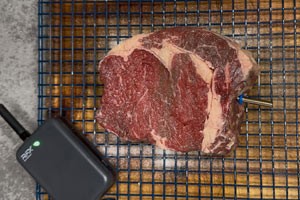
Ribeye is an amazing, flavour-packed cut of beef. Learn how to cook ribeye steak medium rare using the reverse sear...

Elky Whittaker, aka The Smokin’ Elk, began barbecuing as a hobby 10 years ago. Today, he has 262k Instagram followers...
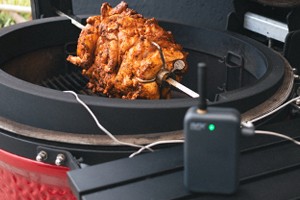
Juicy BBQ chicken shawarma recipe with homemade flatbreads and garlic sauce.
Archive
Popular Recipes
